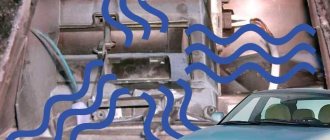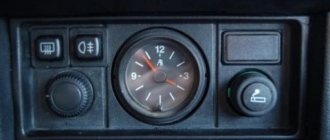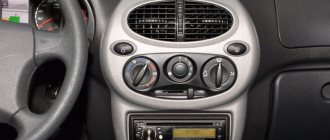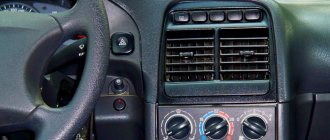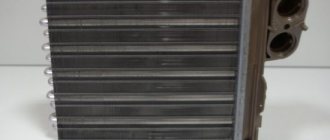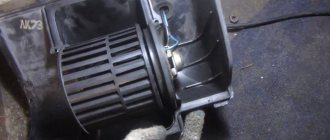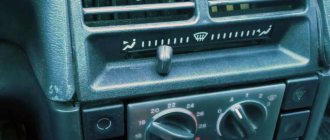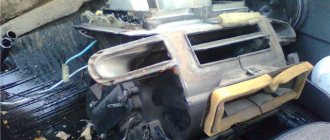If there is quite a strong frost outside, and the interior of your car does not warm up in any way, you should pay attention to the serviceability of the engine cooling system, since the performance of the Lada Granta stove depends on it.
- Coolant. The condition of your car’s coolant should be constantly monitored, and not only when the heater in the Lada Granta is not heating well. The normal coolant level should be kept between about and the “maximum” of the corresponding tank.
If the level is too low, problems with the sealing of the entire cooling system may occur. As a result, the pressure inside the system decreases significantly. If this problem is not resolved, then there is no point in hoping that the stove in the Lada Granta will work well.
- Thermostat. It may happen that in the thermostat position, in which the coolant circulates in a large circle, the thermostat valves become stuck. This is the reason that in the cold season the coolant is simply not able to warm up to normal temperature and ensure good operation of the stove.
In order to be convinced of the presence of this particular problem, it is necessary, no matter how strange it may sound, to get into a traffic jam.
If the problem is really in the thermostat, then the car will literally begin to overheat in a matter of minutes. And when driving along the highway at a decent speed, the engine, on the contrary, will cool too quickly.
- Air temperature regulator damper. If the stove in your Lada Granta does not work well enough, perhaps the reason lies in the functioning of the air temperature regulator damper. And all because the position of the damper directly determines the intensity of the air flow that will pass through the heater radiator, as well as the amount that will enter the car interior, bypassing the radiator.
- Heater fan and fuse. It is necessary to monitor very carefully whether the heater fan starts working. If this does not happen, you should check the functionality of the fuse called 30A. It is green in color and indexed F4, located in the additional concentration of power fuses, which is under the hood, not far from the expansion tank.
If it turns out that the fuse is in working order, most likely the stove is not working well or not working at all due to a malfunction of the electric fan motor. You can get to it only through a special hole, which will become accessible after the glove compartment lid is removed. In the case when the fan operates at its maximum speed, but the air still does not flow well into the cabin, the problem lies in the contamination of the cabin filter, which should be thoroughly cleaned, or even better, replaced with a new one.
- Resistor block. If the heater fan of your Lada Granta works exclusively at the fourth speed, and at the first three completely refuses to show signs of life, it’s time to pay attention to the resistor unit.
Unfortunately, this part cannot be repaired, so if a malfunction is detected, it will have to be completely replaced. You can get to the resistor block in the same way as to the electric motor.
If a car is, in fact, a second home for you, but only on “wheels,” then, of course, you will not give up on the problem of poor interior heating. Nobody wants to be in a “metal freezing trap” in winter. But this is exactly how you can view a car in which the stove refuses to function. The masters know exactly what to do in this case, but for such knowledge, and even more so for their actions, you will have to pay by taking several large bills out of your wallet with great sadness. We suggest that you do not follow traditional methods of solving the problem, but roll up your sleeves to independently find and eliminate the reasons why the stove in your Lada Granta does not work.
If the heater on your car stops working, you need to check the serviceability of not only the heater itself, but also all other devices included in the heating and cooling system. The failure of any link provokes a failure of the entire system or its individual part. Experienced car owners recommend not to wait for a problem to arise, but to periodically arrange preventive examinations for your “iron friend”, then you can prevent undesirable consequences.
If the stove begins to supply only cold air into the cabin, the following may be the trigger:
- insufficient coolant level;
- poor thermostat performance;
- the damper does not close completely;
- a broken fan;
- burnt fuses or resistor.
It is for this reason that it is useful to have your entire heating and cooling system inspected.
Restoring the heater
First you need to check the coolant level. It should not be lower than what is indicated by the manufacturer. The manufacturer indicates two critical levels on the expansion tank: maximum and minimum. The liquid should not go beyond these two boundary states. A low level of coolant provokes a decrease in pressure inside the cooling system, in this case it is very stupid to hope for excellent operation of the stove, and accordingly, there is no point in counting on the fact that the cabin will become warm.
As soon as the level drops, the owner must top up the coolant used. Mixing antifreeze and antifreeze should not be allowed. Otherwise, a chemical reaction may occur, causing the radiator to become clogged with sediment. An excessively dirty radiator will interfere with the normal operation of the stove.
If you actually find a dirty radiator, we recommend that you wash it. You can purchase special chemicals, pour them inside the device, and also clean the upper surface of the radiator using such products. Often drivers, noticing a radiator leak, decide to quickly solve the problem. To do this, they go to an auto store where they purchase sealant. Of course, the sealant can be considered as a real “savior” if there is a leak along the way. However, it must be used if other methods of eliminating leaks are not available. The sealant plugs the holes, stopping the leak, but at the same time it also clogs important parts of the radiator, as a result of which its performance decreases.
Sometimes the thermostat fails, or rather, its valve begins to work incorrectly. For this reason, the circulation of the liquid is disrupted; accordingly, it cannot warm up normally and ensure the successful supply of warm air to the car interior. It’s easy to check the version of a failed thermostat. Start the stove and continue driving along the route you need. At this moment, if the thermostat is faulty, the stove will “go on strike” and refuse to heat the interior of your Lada Granta. As soon as you get stuck in a traffic jam or stop on purpose, as if being in forced downtime, you will notice that your stove will simply begin to “boil”. However, having resumed movement, the stove will again begin to cool quickly. Having noticed such “oddities” in your heater, you can be absolutely sure that you need to change or repair the thermostat.
Antifreeze affects the functioning of the stove
Everyone knows that the cooling circuit contains its own liquid, due to the circulation of which heat is removed from the Lada Kalina engine. Kalina's heating system has its own radiator. Sometimes a reduced level of antifreeze can cause a decrease in the efficiency of the stove, that is, the stove does not heat well. Here you will need to open the hood cover and visually assess the level in the corresponding system tank. It should be located between the upper and lower marks corresponding to the maximum and minimum.
Another common reason is insufficient heat removal and the stove again does not heat well. The reason for this may be the presence of an air lock in the circuit. Is it possible to check it? Yes! With the engine cool, grab the upper and lower radiator hoses with your hand and squeeze them. The absence of gurgling is the main condition for which there is no plug. If the situation is the opposite, then we “expel” the air from the circuit. To do this, open the tank lid and, lifting the front of the car, start the Lada Kalina engine. Let it run for some time (4-5 minutes), periodically revving the accelerator. Then lower and close the lid.
The radiator is clogged
The second reason that could be is that the stove, that is, its radiator, is clogged. It can be washed without removing it. The inlet and outlet pipes come from under the hood from the engine. You just need to find them. In the engine compartment, plug and muffle the pipes without draining the antifreeze.
After this, you can wash and blow out the stove. It can be washed with running water, but do not create high pressure. Do not use a compressor. The pressure in the engine cooling system is about 1 atmosphere. But, if you start putting pressure there from 2 atmospheres or higher, the heater radiator will burst. It's not designed to withstand that kind of pressure.
Some car owners immediately connect the air compressor and start blowing. This must be done carefully, under slight pressure, counting on a pressure of up to 1 atmosphere.
We blew it out, washed it, made sure everything was fine, dirt came out, checked the serviceability of the faucet. Don't forget to add antifreeze and run the system at 3000 rpm to remove any air pockets. In this case, the tap to the stove must be open. After this, the stove will start working normally, and the cabin will just be hot.
You can use chemicals to clean the radiator; it is up to you to decide what to rinse with. But this must be done if the stove does not heat well. Then it will work perfectly.
Thermostat as one of the culprits for poor stove performance
This detail can also “upset” the deterioration of the stove’s performance. Checking the correct functioning of the thermostat can be done in two ways:
- The product will need to be dismantled. You must first drain the liquid from the circuit, and then remove the thermostat itself. Place it in a pan filled with water and heat it. As the temperature approaches boiling, we observe the behavior of the valve in the thermostat. If it opens to its full stroke (at 85 degrees Celsius), then the product is in good condition. When such movement does not occur, we identify a malfunction.
- No dismantling. We warm up the engine and, opening the hood, find the upper and lower pipes of the radiator assembly. We touch the lower hose (with gloves on) and determine the heating temperature by touch. If the pipe has not warmed up, this means that the valve is not able to open, and the liquid circulates only inside a small circle, without passing through the radiator. The result is replacing the thermostat.
Pump malfunction
Very often, drivers explain poor performance of the heater at idle by a breakdown of the water pump. This is due to the fact that at XX the pump impeller rotates at low speed, which cannot ensure high-quality circulation of antifreeze (antifreeze). As a result, heat exchange deteriorates and insufficiently hot air enters the cabin. When you press the gas pedal, the speed of rotation of the impeller increases, which immediately entails an increase in the air temperature in the cabin.
For more accurate diagnostics of the pump, it must be removed from the engine. Very often, a pump malfunction is accompanied by overheating of the motor. A visual inspection of the item will indicate its condition. If the impeller is jammed, spins on the shaft, or its blades are scattered, the pump must be replaced.
Sensor that measures the temperature in the cabin
It is located in the ceiling of the Lada Kalina, close to the lighting lamp and perceives the temperature regime of the atmosphere inside the cabin. The element can also affect the operating mode of the stove. This occurs by comparing the actual temperature with the parameters set by the driver on the dashboard. Thus, the electronics adjusts the position of the dampers based on the “scanned” situation, and it seems to the driver that the stove has stopped responding to his “requests”. The reason for the disagreement is usually the banal oxidation of the contact group of the sensor, due to which it ceases to function correctly. The solution to the problem is to clean the contacts or replace the component.
Microwave device
To make it easier to repair a microwave oven, let’s get acquainted at least in general terms with its structure. What interests us most is its “insides.”
Microwave oven device
The magnetron produces microwaves. It is connected to the camera by a rectangular waveguide. In some models, the waveguide is covered with a piece of mica (a gray-brown material similar to metal), in others it is covered with a plastic cover. The magnetron is powered by a transformer, capacitor and diode. The power supply circuit often contains a high-voltage fuse that protects the transformer from overload.
There is a fan to cool the magnetron. Warm air from the magnetron also enters the working chamber through the air duct, which speeds up the heating of food. Steam and excess air are removed from the chamber through special holes that do not allow radiation to pass through.
Microswitches for locking the closed door
To prevent the microwave oven from working with the door not tightly closed, locking microswitches are installed. As long as their buttons are not pressed (the doors are not closed), power is not supplied. When the door is opened, the power circuit is interrupted instantly. One of the reasons that the microwave oven does not turn on is the breakdown or sticking of these small parts.
The number of microswitches depends on the model. There can be from 2 to 5 pieces. Some manufacturers also use them in the start button and power control circuits. So one of the reasons why the microwave does not heat may be damage to the microswitch in the power control circuit.
An incandescent lamp is installed in the chamber for lighting. Most often it is located inside the air duct.
Operating modes are set from the control panel. It may contain electromechanical switches, or it may be based on a microprocessor. Digital control can again have options: there may be regular buttons that select the mode, or there may be a touch panel. If a problem occurs with the controls, it is better not to get into electronics without knowledge and skills. The only thing you can check is how well the conductors are holding. Everything else is only possible if you have the appropriate experience.
Cabin filter
This element is very important because it is “responsible” for the cleanliness of the cabin air. It should be replaced at least every 10 thousand km of distance traveled. Over time, the filter element becomes clogged and becomes unable to effectively pass air flow into the cabin. Replacing the Lada Kalina filter is quite simple. Under the hood is its housing, by opening the lid of which you can remove the used component. We install a new product in its place. We recommend purchasing a filter whose working element contains a carbon base, which allows you to effectively capture not only dust, but also harmful odors.
Electric stove motor
Another component whose failure inevitably leads to the stove losing its sufficient efficiency, that is, if the stove does not heat. The main sign of a breakdown is the absence of the characteristic sound that a working fan motor in the heating circuit can produce. The first step is to check the integrity of the fuse responsible for powering this unit. The fuse link is located inside the mounting block. This consumable item is marked “F5”. If such an event does not have the desired effect, then the LADA Kalina engine will need to be replaced. It is located behind the cabin filter.
Failure of the cylinder head gasket
You need to understand that damage to the cylinder head gasket leads to mixing of oil with antifreeze or exhaust gases entering the cooling system. Usually the problem is quickly diagnosed by obvious signs. But some drivers note that minimal burnout of the gasket may be accompanied by the appearance of excess air in the cooling system.
The only solution may be to replace the cylinder head gasket, but we advise you to take your time and check all other factors first. This is an expensive procedure and a rare problem, so save it for last.
Let's sum it up
So, we have found out the main reasons that provoke a decrease in the efficiency of such an important component in the LADA Kalina car as the heating system, in other words, when the stove does not heat. Having suspected the presence of one or more of the signs of breakdown indicated by us, the driver will need to take measures to find and eliminate the fault.
If a car is, in fact, a second home for you, but only on “wheels,” then, of course, you will not give up on the problem of poor interior heating. Nobody wants to be in a “metal freezing trap” in winter. But this is exactly how you can view a car in which the stove refuses to function. The masters know exactly what to do in this case, but for such knowledge, and even more so for their actions, you will have to pay by taking several large bills out of your wallet with great sadness. We suggest that you do not follow traditional methods of solving the problem, but roll up your sleeves to independently find and eliminate the reasons why the stove in your Lada Granta does not work.
Additional Tips
However, it also happens that the problem with heating the interior consists only of some small mistakes. Therefore, before you start disturbing the service center workers, check whether all the dampers on the stove are set in the required position. It wouldn’t hurt to tug the hot air damper a little.
There is a possibility that it is simply stuck. And, with a significant push, it will be moved from its place.
Hi all! Cold air is blowing from the stove, the thermostat is new, the pump is new, the antifreeze is normal, the cylinder head gasket was changed, the air was removed, only the stove radiator remained untouched and has never been changed in 280,000 miles.
Today I looked into this matter and lost weight from what I saw
by Adminrive · Published 06/27/2016
I close the car and it says that the trunk is not closed.
by Adminrive Published 03/06/2017
Troubleshooting
If the heater on your car stops working, you need to check the serviceability of not only the heater itself, but also all other devices included in the heating and cooling system. The failure of any link provokes a failure of the entire system or its individual part. Experienced car owners recommend not to wait for a problem to arise, but to periodically arrange preventive examinations for your “iron friend”, then you can prevent undesirable consequences.
If the stove begins to supply only cold air into the cabin, the following may be the trigger:
- insufficient coolant level;
- poor thermostat performance;
- the damper does not close completely;
- a broken fan;
- burnt fuses or resistor.
It is for this reason that it is useful to have your entire heating and cooling system inspected.
Restoring the heater
First you need to check the coolant level. It should not be lower than what is indicated by the manufacturer. The manufacturer indicates two critical levels on the expansion tank: maximum and minimum. The liquid should not go beyond these two boundary states. A low level of coolant provokes a decrease in pressure inside the cooling system, in this case it is very stupid to hope for excellent operation of the stove, and accordingly, there is no point in counting on the fact that the cabin will become warm.
As soon as the level drops, the owner must top up the coolant used. Mixing antifreeze and antifreeze should not be allowed. Otherwise, a chemical reaction may occur, causing the radiator to become clogged with sediment. An excessively dirty radiator will interfere with the normal operation of the stove.
If you actually find a dirty radiator, we recommend that you wash it. You can purchase special chemicals, pour them inside the device, and also clean the upper surface of the radiator using such products. Often drivers, noticing a radiator leak, decide to quickly solve the problem. To do this, they go to an auto store where they purchase sealant. Of course, the sealant can be considered as a real “savior” if there is a leak along the way. However, it must be used if other methods of eliminating leaks are not available. The sealant plugs the holes, stopping the leak, but at the same time it also clogs important parts of the radiator, as a result of which its performance decreases.
Sometimes the thermostat fails, or rather, its valve begins to work incorrectly. For this reason, the circulation of the liquid is disrupted; accordingly, it cannot warm up normally and ensure the successful supply of warm air to the car interior. It’s easy to check the version of a failed thermostat. Start the stove and continue driving along the route you need. At this moment, if the thermostat is faulty, the stove will “go on strike” and refuse to heat the interior of your Lada Granta. As soon as you get stuck in a traffic jam or stop on purpose, as if being in forced downtime, you will notice that your stove will simply begin to “boil”. However, having resumed movement, the stove will again begin to cool quickly. Having noticed such “oddities” in your heater, you can be absolutely sure that you need to change or repair the thermostat.
The culprit for poor operation of the stove in the Lada Grant may be the damper. By adjusting its position, the driver manages to change the intensity of the warm air flow. If the damper does not open completely, you should disassemble part of the panel, get to the dampers and check the quality of their movement. If a broken cable is detected, you simply need to replace it, after which the damper will begin to work as expected, and the stove will begin to delight you with active heating of the interior.
The cause of the failure may be poor performance or complete absence of the fan. The device may stop functioning if its electric motor burns out. Fortunately, Lada Granta owners have to deal with this situation much less often. However, every driver has to deal with blown fuses in his life. Any surge in the electrical network provokes failure of this element. If you have such a problem, you just need to remove the unusable one and install a new fuse.
Also, the fan may not work if the cabin filter is excessively dirty. In this case, simply replace the identified “source of trouble”, make sure that after this not only the fan starts working, but also heat actively begins to flow into the cabin.
Sometimes you may find that the fan is working, but only if you select the fourth speed. If your choice falls on other speeds, your fan will remain silent. In this case, we confidently declare that a burnt-out resistor could have caused such a failure. Of course, in this case it just needs to be replaced.
So, Lada Granta owners sometimes have to feel the consequences of poor-quality stove operation, when the whole body freezes to the bones. However, using our recommendations, you can not only quickly identify the cause of the failure, but also eliminate it quite easily and effectively.
Rules for using a standard heating system
The car's operating manual outlines the basic principles of operation of the ventilation, air conditioning and interior heating systems. To quickly warm up, you need to switch the damper to the air recirculation position and the fan speed to the “maximum” position. In this case, the car windows must be closed. You should not drive in this mode for a long time, as this can lead to fogging of the windows.
The main reason for the accumulation of condensation is the difference in temperature inside and outside and high humidity. To prevent the windows from fogging up, you need to warm them up by pointing the heater deflectors at them and dry the air by turning on the air conditioning. However, when the vehicle is driven under heavy loads (for example, on long climbs) with the air conditioning turned on, the engine may overheat, so in such conditions it is necessary to monitor its temperature. Condensation is usually the result of luggage blocking the vents.
Incorrect operation of the ventilation and heating system may be caused by a malfunction of the temperature sensor located in the interior lamp. It is not recommended to drive with the windows open in hot weather with the air conditioning running.
The vehicle's ventilation, air conditioning and heating system creates conditions for normal and comfortable driving in any climate zone. AvtoVAZ engineers developed and implemented a simple and reliable heating concept for the Lada Granta model. But for the system to operate effectively, certain rules must be followed, which will help avoid unexpected breakdowns.
The Lada Granta passenger car, which is considered one of the most affordable in the world, is equipped with a “stove” (or simply a heater) that is standard for VAZ cars. Typically this unit works very well, but problems can still occur. Therefore, if the Lada Granta stove does not heat well, then there must be reasons for this that simply need to be discovered.


